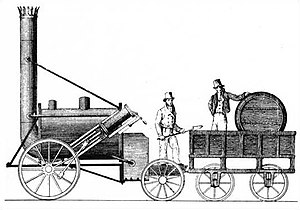
Back Ракета (паравоз) Byelorussian Rocket (lokomotiva) Czech Rocket Stephenson Welsh Rocket (damplokomotiv) Danish Rocket (Lokomotive) German The Rocket Spanish Stephensonin Rocket-veturi Finnish Fusée de Stephenson French Rocket Hungarian Locomotiva Rocket Italian
| Rocket | |||||||||||||||||||||||||||||||||||||||||||||||||
|---|---|---|---|---|---|---|---|---|---|---|---|---|---|---|---|---|---|---|---|---|---|---|---|---|---|---|---|---|---|---|---|---|---|---|---|---|---|---|---|---|---|---|---|---|---|---|---|---|---|
 A contemporary drawing of Rocket | |||||||||||||||||||||||||||||||||||||||||||||||||
| |||||||||||||||||||||||||||||||||||||||||||||||||
| |||||||||||||||||||||||||||||||||||||||||||||||||
| |||||||||||||||||||||||||||||||||||||||||||||||||
| |||||||||||||||||||||||||||||||||||||||||||||||||
Stephenson's Rocket is an early steam locomotive of 0-2-2 wheel arrangement. It was built for and won the Rainhill Trials of the Liverpool and Manchester Railway (L&MR), held in October 1829 to show that improved locomotives would be more efficient than stationary steam engines.[7]
Rocket was designed and built by Robert Stephenson in 1829, and built at the Forth Street Works of his company in Newcastle upon Tyne.
Though Rocket was by no means the first steam locomotive, it was the first to bring together several innovations to produce the most advanced locomotive of its day. It is the most famous example of an evolving design of locomotives by Stephenson that became the template for most steam engines in the following 150 years.
The locomotive was preserved and displayed in the Science Museum in London until 2018, after which it was briefly exhibited at various sites around the U.K. until it came to rest at the National Railway Museum in York. Since 2023, it has been based at the Locomotion Museum in Shildon.[8]
- ^ "Rocket" (PDF). Rainhilltrials.com. Archived from the original (PDF) on 5 October 2013. Retrieved 22 August 2012.
- ^ a b c d "Engineering Timelines – Rocket, Stephenson's locomotive".
- ^ a b Dawson, Anthony. Locomotives of the Victorian Railway: The Early Days of Steam. United Kingdom, Amberley Publishing, 2019.
- ^ Smiles, Samuel. The Story of the Life of George Stephenson: Including a Memoir of His Son Robert Stephenson. United Kingdom, John Murray, 1873.
- ^ Richard, Gibbon. Stephenson's Rocket Manual: 1829 Onwards. United Kingdom, Haynes Publishing UK, 2016.
- ^ "Stephenson's Rocket". The Science Museum Group. Retrieved 11 November 2018.
- ^ Carlson (1969), pp. 214–215, 219, 223.
- ^ "Stephenson's iconic Rocket to be displayed at Locomotion in Shildon | National Railway Museum". 2 March 2023.